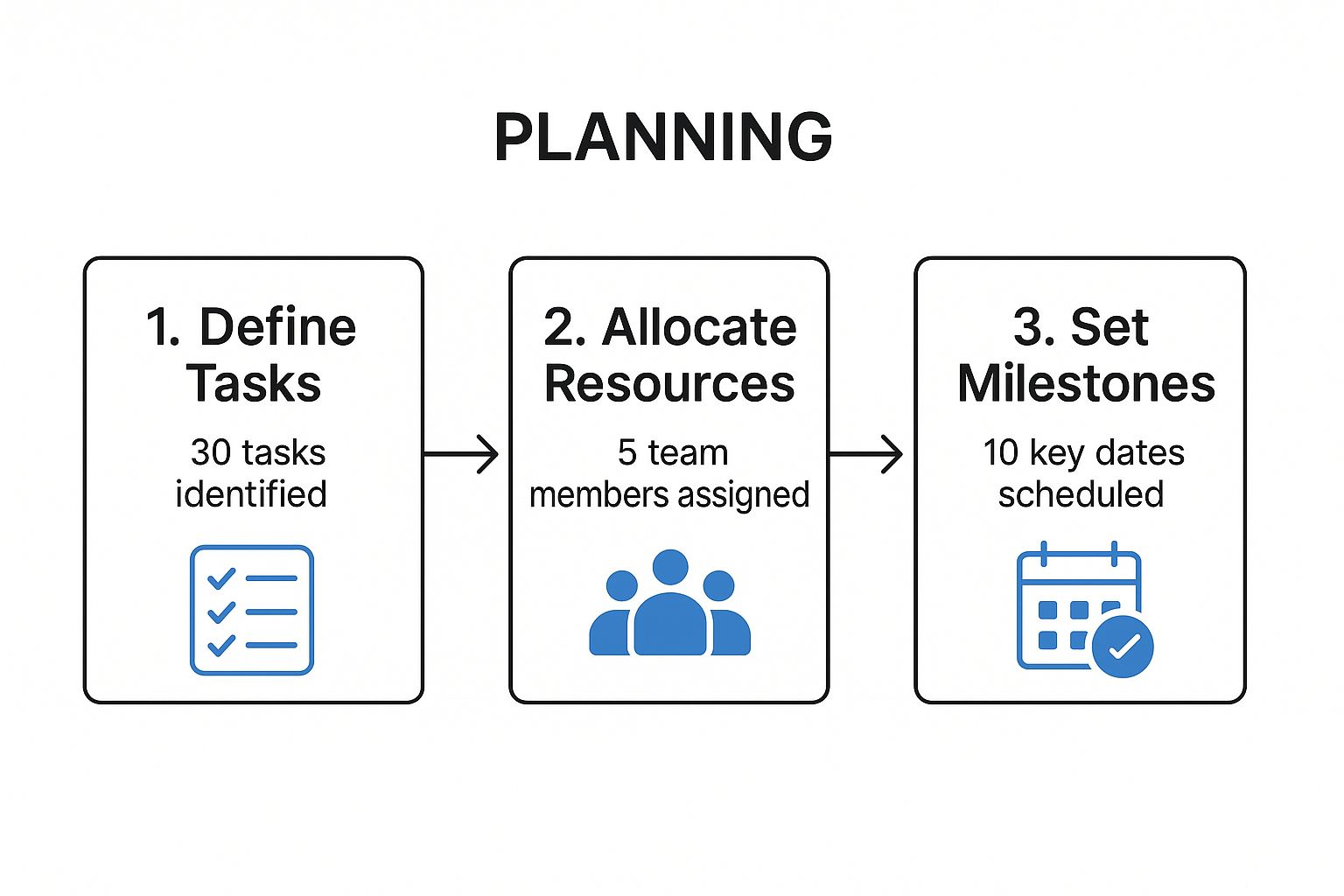When we talk about project timeline management, we’re not just talking about a simple calendar. It’s the entire process of mapping out, keeping an eye on, and steering a project's schedule from the first day on site to the final handover. For a complex build like a self-storage facility, getting this right is absolutely essential to ensure every task clicks into place, on time and within budget.
Why So Many UK Project Timelines Go Off the Rails
Let’s be honest, project delays are the rule, not the exception. Far too many construction projects in the UK, especially in a niche field like self-storage installation, end up missing their deadlines and blowing their budgets.
This isn’t just a small hiccup; it has a real financial sting. Every single week a new facility's opening is pushed back is another week of lost rental income, which eats directly into the project's return on investment.
These setbacks usually boil down to a few common problems that solid timeline management can head off at the pass.

Unpacking the Common Causes of Delays
It often starts with weak planning right out of the gate. A schedule that’s too optimistic and fails to properly account for long material lead times or the availability of specialist subcontractors is basically designed to fail. In the same way, getting the resource allocation wrong—whether it’s people, machinery, or materials—creates bottlenecks that send shockwaves through the entire project.
Then you have the unexpected site issues that can stop work in its tracks. Things like discovering tricky ground conditions or having to navigate complicated utility connections can bring progress to a grinding halt. Understanding the specific reasons for natural gas project delays, for example, can give you a heads-up on potential utility snags.
The reality is stark: project timeline management is a massive challenge in the UK. Industry data shows that only about 34% of organisations actually finish their projects on time. That means a staggering two-thirds are dealing with costly delays.
This struggle points to a huge gap between what’s planned on paper and what happens on site. In fact, when you dig a bit deeper, you find that only 29% of companies say they consistently hit their project deadlines. It’s a sobering thought.
Even with the best intentions, projects can get derailed. Here’s a quick look at some common obstacles and how a robust timeline management plan can help you navigate them.
Common Timeline Obstacles and Solutions
| Challenge | Impact on Timeline | Management Solution |
|---|---|---|
| Material Delays | Pushes back all dependent tasks, leading to cascading delays. | Build in buffer time for key materials and confirm lead times before finalising the schedule. |
| Subcontractor Unavailability | Creates gaps in the workflow, leaving crews idle and extending the project duration. | Book subcontractors well in advance and maintain regular communication to confirm their schedule. |
| Unexpected Site Conditions | Can halt all work, requiring costly and time-consuming redesigns or remediation. | Conduct thorough site investigations early and create contingency plans for common issues. |
| Scope Creep | Unplanned changes add work and complexity, stretching the original timeline and budget thin. | Implement a formal change order process to evaluate the impact of any requested changes before approval. |
Ultimately, a well-managed timeline is your best defence against these all-too-common project killers.
Moving From Guesswork to a Solid Strategy
Turning a timeline from a hopeful guess into a genuine strategic tool means facing these common pitfalls head-on. It also requires a solid grasp of external factors. For instance, getting your head around the relevant building regulations from the very beginning helps prevent late-stage rework and frustrating approval delays.
By spotting these challenges early, you can build a management process that’s realistic, resilient, and effective. This proactive approach is what successful project delivery is all about—protecting your budget, your schedule, and your reputation.
Creating a Realistic and Defensible Timeline
A successful self-storage project is built on a realistic timeline, not just an optimistic one. From day one, your schedule needs to be a practical, defensible document that can hold up under the inevitable pressures of a complex construction job. The only way to achieve this is by breaking down the entire project into granular, manageable tasks.
For a self-storage installation, this means going far beyond a simple to-do list. You need to map out every single step, from initial site surveys and groundwork preparation right through to installing the final security systems and access controls. Think of each major component as its own mini-project with a dedicated timeline.
Deconstructing the Project into Actionable Tasks
The first move is to get everything out of your head and onto paper. Really think through the entire build sequence. What absolutely has to happen before the concrete slab can be poured? What’s the real-world lead time for the steel partitioning you need?
For a typical self-storage build, a rough breakdown might look something like this:
- Pre-construction Phase: This covers the initial legwork – site surveys, geotechnical reports, architectural drawings, and crucially, securing planning permission.
- Site Preparation: Now you’re on-site. This involves clearing the area, excavation, laying foundations, and getting all the underground utilities in place.
- Building Erection: The structure starts to take shape with steel frame construction, roofing, and fitting the external cladding.
- Internal Fit-Out: This is where it starts to look like a storage facility. We’re talking about installing the partitioning, any mezzanine flooring, running electrical wiring, and setting up fire protection systems.
- Final Touches: The last push includes security camera installation, setting up the access control system, painting, and a final, thorough site clean-up.
This detailed process flow infographic shows how we begin to define these tasks, allocate the right resources, and set those all-important milestones.

Seeing the project visually like this from the outset is a brilliant way to ensure no major stage gets missed before you dive into the nitty-gritty of scheduling. It’s a foundational step you just can't skip on a complex build.
Estimating Durations and Mapping Dependencies
Once you have your task list, the next challenge is putting a realistic timeframe on each item. This is absolutely not a solo activity. You need to get your key suppliers, subcontractors, and team members involved to get genuine duration estimates based on their hands-on experience. A steel fabricator will give you a far more accurate lead time for materials than you could ever guess.
Just as important is mapping the critical dependencies—those are the tasks that simply must be finished before others can even begin. For example, you can’t start putting up the steel frame until the foundations are fully cured. This is where project management tools like Gantt charts become invaluable for seeing how everything connects.
A Gantt chart gives you a clear visual of the project's critical path, making it immediately obvious how a delay in one area will ripple through and affect the overall finish date. To build a truly defensible timeline, you have to understand every stage, as shown in guides that explain the detailed process of project execution for similar construction projects.
A timeline isn't just a schedule; it's a communication tool. It aligns everyone—from the investors to the groundwork crew—on the plan of action, the key milestones, and their individual responsibilities.
By anticipating roadblocks like material lead times or subcontractor scheduling clashes right from the start, you build a much more robust plan. For a deeper dive into managing these complexities, our guide on https://psllimited.co.uk/storage-facility-project-management offers more detailed insights. This kind of proactive approach is what turns your timeline from a fragile document into a powerful management asset.
Choosing Your Timeline Management Toolkit
A brilliant plan is only as good as the tools you use to execute it. To keep your self-storage installation on track, you need a system that gives you a clear, real-time picture of your progress – something that goes far beyond a simple to-do list. The right toolkit can be the difference between steering the ship and just reacting to the waves.
For a small, straightforward fit-out, you might be tempted to use a basic spreadsheet. It’s familiar, and it can handle simple tasks and deadlines. But let's be honest, it breaks down quickly. Spreadsheets can't manage dependencies or reallocate resources on the fly. When a steel delivery is delayed, that spreadsheet won’t automatically shift every related task, leaving you to manually unpick and rebuild the entire schedule. That’s a recipe for error.

Stepping Up to Dedicated Software
This is where dedicated project management software really shines. Tools featuring Gantt charts and critical path analysis give you a powerful, visual map of your entire project. You can see exactly how tasks are linked and instantly grasp the knock-on effect of a delay. For a complex multi-storey self-storage build, this kind of insight is non-negotiable.
These platforms act as a single source of truth, a central hub for all project information. This ensures everyone, from the site manager to the client, is singing from the same, up-to-date hymn sheet.
The right software doesn't just track your timeline; it actively protects it. Think of it as an early warning system, flagging potential bottlenecks before they become full-blown crises and giving you the data to make smart decisions, fast.
The Rise of AI in Timeline Management
The next big leap is artificial intelligence. AI-powered tools are no longer the stuff of science fiction; they're fast becoming a standard piece of the modern project management puzzle. In fact, it's expected that by 2025, around 70% of UK project managers will be using AI tools to help automate their scheduling and reporting. You can read more about these technological trends in project management.
These aren't just fancy algorithms. They analyse data from your past projects to predict where delays are most likely to happen and which tasks carry the highest risk. This allows you to build contingencies right where they’re needed most.
Imagine a system that flags a key materials supplier with a history of late deliveries in winter, then suggests reordering your installation schedule to buffer against that risk. That’s the kind of predictive power that changes the game, shifting timeline management from a reactive headache to a proactive strategy.
Ultimately, the best tool is the one that fits the scale of your project, the way your team works, and your budget. Whether it’s an all-singing, all-dancing platform or a simpler, focused app, the goal is always the same: gain clarity, improve collaboration, and keep a firm grip on your project timeline from day one to handover.
Keeping Your Project Timeline on Track
Crafting a detailed timeline is a great start, but it’s the active, day-to-day management that makes or breaks a project. This is where the plan meets reality, and your ability to monitor progress becomes your most valuable skill. Winning projects aren't defined by perfect plans, but by how well teams adapt when those plans inevitably get tested.
The real key to successful timeline management is shifting from a reactive to a proactive mindset. Don't wait for a problem to snowball into a full-blown crisis. Instead, you need to spot the earliest warning signs and make small, intelligent adjustments along the way. It’s about moving beyond a simple "are we on schedule?" to asking, "what could knock us off schedule next week?"
From Baseline to Real-Time Progress Tracking
Think of your initial timeline as your baseline—the benchmark against which everything else is measured. Consistent and brutally honest tracking is the only way to know if you're holding true to that baseline. This requires far more than just ticking boxes; it demands a real-time view of what’s actually happening on site.
Regular check-ins are vital, but they have to be productive. A good site meeting isn't just a status update; it's a forward-looking strategy session.
- Focus on the critical path: Always start by reviewing the tasks that directly impact your project's completion date. No fluff.
- Identify upcoming risks: Talk about potential roadblocks for the next 7-14 days. Is that key material delivery confirmed? What does the weather forecast say about the roofing work?
- Agree on concrete actions: If a task is slipping, decide on a specific course correction right there and then. Don't leave it vague.
Your project management software should be the live dashboard for your project's health. It needs to give you instant visibility, letting you see if the groundwork is 5% behind schedule or if the electrical first fix is running 10% ahead. This data is what empowers you to make informed decisions, not just educated guesses.
This granular level of tracking lets you handle small slips before they create a domino effect. For instance, knowing the foundation work is just a day behind schedule allows you to immediately phone the steel erection crew. Can they absorb that minor delay without it pushing back their start date? It's these small conversations that save big headaches later.
Making Proactive Course Corrections
Let’s look at a real-world scenario from a self-storage build. Your timeline shows that the internal partitioning installation is due to start in three weeks. A proactive check with your supplier reveals a potential snag in their manufacturing process.
Instead of just waiting for the bad news to land, you can act now. Could you reshuffle the schedule to bring another internal task forward, like the electrical wiring, that doesn't depend on the partitions? This smart adjustment keeps your crews busy and minimises costly idle time, preserving the project's overall momentum. If you want to see how we handle these kinds of complex jobs on site, you can explore the details of our professional manufacture and installation services.
This is proactive course correction in action. It's all about using real-time information to make agile decisions that protect your end date. Effective project management isn’t about rigidly sticking to a plan no matter what; it’s about having the visibility and flexibility to steer the project back on course whenever it starts to drift. This constant vigilance is what turns your timeline from a static document into a dynamic tool for success.
Handling Setbacks and Keeping Everyone in the Loop
Let’s be realistic: no matter how meticulously you plan, things can go sideways. On any self-storage installation, the true measure of your timeline management isn't just about crafting a flawless schedule from the start—it’s about how you react when things don't go according to plan. How you communicate a setback is often what separates a minor speed bump from a full-blown crisis.
Nobody enjoys being the bearer of bad news, but burying your head in the sand is the worst thing you can do. Delays are part of the game. Maybe it’s a week of torrential rain that brings groundworks to a halt, or a supplier has a hold-up with the steel partitioning. Trying to hide the problem or just hoping it will sort itself out is a guaranteed way to destroy trust and turn a small issue into a project-derailing disaster.

A Blueprint for Clear Communication
When a delay becomes unavoidable, your response needs to be fast, clear, and professional. This isn't about making excuses; it's about showing you're in control and have a solid plan to get back on track. Your stakeholders, from investors to the final client, need to feel confident that you’ve got this handled.
A haphazard phone call won't cut it. You need a structured approach that offers more than just an apology.
-
Pinpoint the Cause: Get straight to the point and be honest about what’s happened. Saying, "The exceptional rainfall last week has completely waterlogged the site, making it unsafe to pour the concrete foundations," is infinitely better than a vague, "We're running a bit behind schedule."
-
Offer a Concrete Solution: Don't just present a problem—present the fix. Follow up immediately with, "We've already hired industrial pumps to clear the water, and I’ve scheduled our groundworks team to work through the weekend to make up for lost time." This proves you’re already on the front foot.
-
Share a Revised Timeline: This is what everyone really wants to know. Provide a realistic new completion date for that specific milestone and explain how you’re shuffling other tasks to prevent a domino effect across the rest of the project.
Being upfront and transparent when a delay hits is one of your most powerful tools. It turns a potential crisis into proof of your competence and reinforces the client's faith in your ability to see the project through.
Turning a Problem into a Positive
Here’s a real-world example. Imagine the custom-sized roller doors for your units are delayed by two weeks at the factory. The worst thing to do is wait until the original delivery date has passed to mention it.
Instead, the moment you get the news from the manufacturer, you pick up the phone to the client.
You clearly explain the hold-up, confirm the new delivery date, and—crucially—present a revised work schedule. You show them how you’ve reorganised the sequence to let the electricians and painters get all the internal work done in the meantime.
By doing this, you're not just dropping a problem in their lap; you're actively managing it right in front of them. That’s the kind of professionalism that protects your working relationship and keeps the project's integrity intact. This is what excellent timeline management looks like in the real world.
Common Questions About Managing Project Timelines
Even the most meticulously planned project throws up questions. It’s just the nature of the beast. With that in mind, I’ve put together some answers to the most common queries we get about keeping self-storage installations on track.
What's the Single Biggest Mistake People Make with Timelines?
Hands down, it's being too optimistic. I see it all the time. During the initial excitement of the planning phase, it's easy to gloss over potential risks or forget just how long certain tasks really take. The result is a fragile schedule with no room to breathe.
Think of it this way: a timeline without any buffer is like a house of cards. One small gust of wind – a single material delivery that’s a day late – can make the whole thing wobble. Smart timeline management means facing potential risks head-on from the start and building in realistic time buffers, especially around the most critical jobs.
How Should I Deal with Scope Creep?
Ah, scope creep. That slow, silent killer of timelines. It happens when small, unmanaged changes start piling up, slowly expanding the project's original requirements. The best way to tame it is with a solid change control process right from the get-go. This isn't about blocking every new idea, but about handling them smartly.
When a stakeholder asks for a change, your first move should be to assess its real-world impact. How will it affect the timeline, the budget, and the resources you have? Once you have a clear picture, you present that analysis back to them so they can make a properly informed decision.
If a change gets the green light, you must officially update the project's baseline schedule and budget. This simple, formal step stops 'scope bleed' in its tracks and makes sure everyone understands the trade-offs involved. Your best defence is always clear, documented communication.
How Can I Get My Team to Actually Stick to the Schedule?
Getting buy-in from your team starts with bringing them into the planning process. When your crew helps you estimate how long tasks will take, you get more than just accurate numbers – you get a genuine sense of shared ownership over the schedule.
Here are a few practical things that work for us:
- Break it down: Don't just give them a huge end date. Deconstruct the project into smaller, more manageable tasks, each with its own deadline. It makes the whole thing feel less daunting and lets you track progress much more effectively.
- Show, don't just tell: Use visual tools like Gantt charts. They give everyone a clear picture of the entire project and help them see exactly how their individual work slots into the bigger plan.
- Recognise the wins: When a key milestone is hit, celebrate it. It’s a massive boost for morale and keeps the momentum going. And if a task does slip? Address it as a team, focus on finding a solution, and leave the blame game at the door.
What's the Best Software for Construction Timelines?
For a complex job like a self-storage installation, you need a tool that can handle the moving parts. You should be looking for software with powerful Gantt chart features, the ability to perform critical path analysis, and really solid resource management functions.
Platforms like Microsoft Project and Smartsheet are great all-rounders. For something more specialised, construction-specific software like Procore or Autodesk Construction Cloud is brilliant. They’re built to handle the complex dependencies, material tracking, and subcontractor schedules that are part and parcel of a build. The right one for you will really come down to the scale of your project, the size of your team, and your budget.
Nailing your project timeline is the foundation of a successful build. At Partitioning Services Limited, we draw on over two decades of hands-on experience and meticulous planning to deliver self-storage projects on time and on budget. Find out how our end-to-end services can maximise your return on investment at https://psllimited.co.uk.
Looking for help with your next project?
Whether you are new to self storage or already have an established self storage facility, we can provide you with guidance and a full quotation for any aspect of your works.

